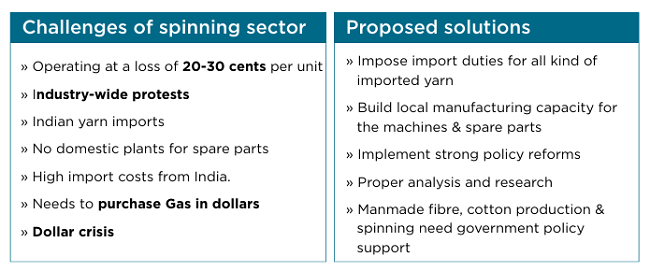Bangladesh’s spinning sector, a critical part of the country’s textile and apparel industry, is facing an unprecedented crisis. For the past two years, spinning mills have been forced to operate at a loss of 20-30 cents per unit. The financial strain has led to widespread layoffs, and the frustration of the industry is beginning to boil over into protests. However, the situation is not unique to the spinning sector alone. The weaving and woven dyeing sectors are experiencing similar turmoil, with job cuts exacerbating the unrest. This crisis calls for urgent policy reforms and strategic decisions to safeguard the future of one of Bangladesh’s most vital industries.

A significant part of the problem lies in the unregulated influx of Indian yarn into Bangladesh under the bond license system, which allows duty-free imports. This policy has severely impacted local manufacturers, even though Bangladesh can produce 80-90% of the yarn needed for the knitting industry and 40% for the woven industry domestically. However, many companies opt for imported yarn, neglecting local production, because of the cost benefits associated with tax-free imports from India. This practice is gradually destabilizing the market and pushing local producers to the brink of collapse. Due to government policy, the incentive for the local yarn based import has become less than the earlier. On the other hand, the incentive gets long time to be matured. For this reason, garments exporters are choosing to import yarn rather than sourcing locally.
To address this challenge, a robust and forward-thinking policy framework is required. First and foremost, all yarn imported from India or any other foreign source should be subject to appropriate taxes. This measure would create a level playing field for local producers, allowing them to compete fairly and potentially gain a stronger foothold in the market. By imposing import duties, the government could protect domestic industries, ensuring they remain competitive and sustainable in the long term.

Another critical issue facing the spinning sector is the lack of local production facilities for essential spare parts, compressors, generators, and other machinery. While India benefits from its domestic manufacturing base, which allows it to sell these components at lower prices domestically, Bangladeshi companies are forced to pay inflated prices for imported equipment. This disparity adds another layer of cost to an already struggling industry. To reduce dependence on foreign suppliers and enhance local capabilities, Bangladesh must invest in building its own manufacturing infrastructure for these vital components.
Moreover, the cost of raw materials is becoming an increasing burden on the spinning sector. Gas, a crucial input for production, has to be purchased from manufacturers in dollars, adding to the financial strain. With the ongoing dollar crisis and challenges in cotton imports, the industry is being squeezed from all sides. As the global economic landscape becomes more uncertain, the need for local solutions becomes even more pressing.
Last but not the least, proper research and analysis must be done to set a long term business policy for the spinning industry of Bangladesh to remain sustainable for the upcoming decades. Immediate government policy support is needed to establish manmade fiber and spinning industry.
The government must take immediate steps to address these issues. A change in policy regarding the importation of foreign products, particularly Indian yarn, is essential to the survival of the spinning sector. Without such reforms, the industry risks losing its competitive edge, which would have devastating effects on employment and economic stability.
In fine, Bangladesh’s spinning sector stands at a crossroads. The current crisis is a wake-up call for policymakers, industry leaders, and stakeholders. It is time for decisive action to protect one of the cornerstones of our economy.
















